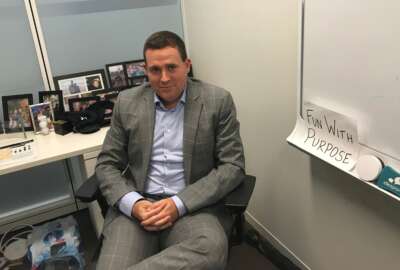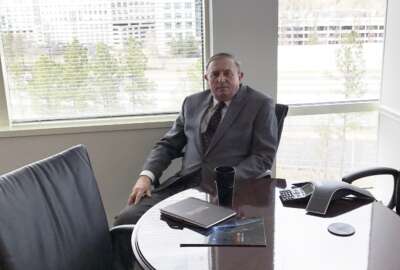
Anticipating change, helping agencies through it
Dan Helfrich, a principal with Deloitte consulting who leads the federal government services practice, said like any sport, sometimes you win and sometimes you lose...
Views from the Corner Office is a new show designed to talk to the private sector leaders that influence and impact the federal market. The goal of this monthly discussion is for federal executives, lawmakers and other industry experts to gain insights and a better understanding into the trends, the challenges and the evaluation of the technology, acquisition and leadership in the federal market by the executives who lead the federal practices of government contractors.

Dan Helfrich, a principal with Deloitte consulting who leads the federal government services practice, sat down with Federal News Radio’s executive editor Jason Miller at his office in Arlington, Virginia.
Best listening experience is on Chrome, Firefox or Safari. Subscribe to Views from the Corner Office’s audio interviews on Apple Podcasts or PodcastOne.
Here are some excerpts from that discussion.
State of the Federal Market
JM: Is it a good time to be a federal contractor?
DH: In one word, it’s a dynamic federal market and dynamism means a lot of different things. It means that things change routinely and you know, for me, change brings lots of opportunities. Dynamic means that new things are happening. New technologies are entering the market. New companies are entering the market. New clients are showing up that have never been federal government employees before, and so, it’s a really dynamic environment that frankly matches an obviously dynamic political market alongside, which again, in my mind, dynamism equals fun because there’s a lot of activity.
JM: When change happens, how do you deal with that from a company perspective?
DH: Why are firms like Deloitte here? Why is this industry here? It’s actually to anticipate the change and to help government agencies go through change and they haven’t been through before. So it’s our job to be investing in what is new so that change isn’t frightening, the change is exciting. Were we two years ago talking about what robotic process automation could mean for this market? Absolutely. Did those germinate into lots of work we were selling two years ago? No. But a year ago it started to and now we have a blossoming market. I think the same thing will happen with blockchain. Were we talking about blockchain 18 months ago and its application in the federal government? We were. Was I training people on blockchain? Yes. Were those people using their blockchain skills on projects that the government was paying for? Not many of them. But today that is starting to happen.
That’s the business we’re in is trying to time what are going to be the most impactful changes and what do I need to do to prepare my team to be ready to help the government through those changes. That’s the sport of figuring out which trends and which skills are going to be the most meaningful in this market and you win some and you lose some in that sport. If you’d succeed more often than not, then you’re going to grow your business.
JM: Give me an example of a trend maybe that you guys thought would come but maybe didn’t.
DH: A couple years ago, I really felt that the government was ready to invest a lot in leadership development and in actually taking all the work that’s been done around human capital, the discussion about how important leadership development is and leaders are to the performance of the organization and sort of invest in heartier more robust leadership development programs and with a few exceptions, it has not played out at the scale that I thought it would.
On MGT Act funding strategies
JM: What do you think is the best approach to hand out the $100 million in funding under the Technology Modernization Fund?
DH: I’d fund 20 projects at $2 million and have them create minimal viable products and prototypes, and then decide which of those should get the other $60 million to go governmentwide or to take on additional use cases in that particular agency. Those of us who run businesses, we all have research and development funding, and one of the lessons I’ve learned is if I give out all X number of millions of dollars of investment or R&D funding by the end of June, I don’t have enough stimulus and enough competition in the system for the best ideas to be done quickly. I would advise those doling out funds to think about that and think about how to make sure there’s always some left in the kitty so that people are competing for and pushing each other to be the best and to get some additional funding. Competition and innovation is a really good thing.
Competition in the federal market
JM: General Services Administration Administrator Emily Murphy says one of her priorities is to talk about competition and to ensure there’s competition, and she says specifically at the task order level. Do you think that’s where it needs to be?
DH: I totally see that as the best for the government, and frankly the best for the community. We can talk about the landscape of the types of projects or the types of tasks that come out on one of these major vehicles and the reality is, they are so different. Where you really understand the mix of labor required to do a deal, how experienced is that labor need to be, what skills does that labor need to have and what’s the mix of solutions and people? All those things happen at a task order level when you can really see, does the vendor understand what I’m asking for? Does the vendor have the past experience to do this task? Does the vendor have a solution and a plan that is scalable to my situation? That stuff happens at the task order level. What you want to make sure is that what doesn’t happen is you have 37 vendors putting in a bid for every task and the whole system gets jammed. And so there’s a happy medium somewhere there. But if I’m an agency buyer, I want to see what folks have to offer specific to my task, not at the uber, uber, uber, everything under the sun for contracting level. That sometimes is the case with some of the GWACs.
Getting behind the mic
JM: Tell me one or two things about yourself personally that maybe people don’t know about you.
DH: The thing that you wouldn’t know about me and many wouldn’t, is I actually trained to be a broadcaster. And my number one hobby is broadcasting soccer. So I was a college soccer player. I broadcast a lot of college soccer, including I’m the voice of Georgetown soccer, which is my alma mater. And I actually find that doing live play-by-play of live sports is incredibly valuable to being successful in this business. Because as you know, if you’re doing live play-by-play, you have to prepare, but then you have to react in the moment to things that you never know what’s going to happen and you have to be articulate as those things happen. And so I find that that hobby is not only a great release for me, but is mutually reinforcing to being successful in this career.
JM: You played a Georgetown, do you still play now?
DH: No, I’ve hung up the cleats long ago. For me, playing at a high level for my whole life, once that part ended, I couldn’t get excited about the coed or the over-35 circuits. So I play once a year or so with the Georgetown team, which is a pretty humbling experience.
Copyright © 2025 Federal News Network. All rights reserved. This website is not intended for users located within the European Economic Area.
Jason Miller is executive editor of Federal News Network and directs news coverage on the people, policy and programs of the federal government.
Follow @jmillerWFED
Related Stories





